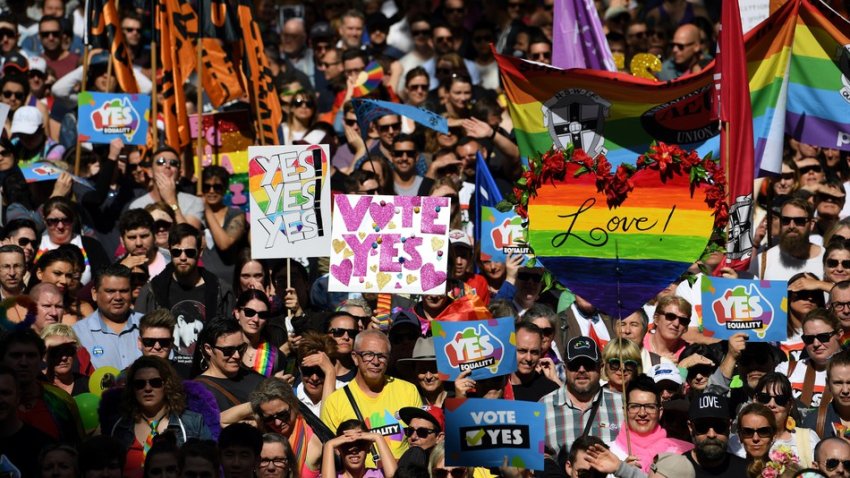
Since the High Court challenge to the federal government’s marriage equality survey was dismissed and the survey received the green light, streets have been painted all the colours of the rainbow as historically large protests and displays of solidarity sweep the country.
The campaign for marriage equality has been fighting the delaying tactics and homophobic policies of Labor and Liberal governments for the past 13 years.
The demand for marriage rights emerged in the context of a society forever changed by the Gay Liberation movement of the late 1960's and 70's, marked in Australia by the first Gay and Lesbian Mardi Gras in 1978.
The Gay Liberation movement made waves by scrapping homophobic “anti-buggery” laws, removing homosexuality from the Australian Medical Association’s list of illnesses and equalising age of consent laws. These gains laid the groundwork that we build upon today.
These historic victories were massive steps forward, but when the marriage equality demand emerged in the early 2000s, homophobia was still widespread.
Thirteen years of struggle
The movement’s trajectory from a niche issue to thousands on the streets participating in nation-wide mobilisations in the face of government intransigence, mark this struggle as one of the landmark civil rights issues of our time.
Like the women’s liberation and Black rights movements, the campaign for an end to Lesbian, Gay, Bisexual, Transgender and Intersex (LGBTI) discrimination under the law took on a fight that seemed almost impossible at the first demonstration for marriage equality in 2004, when former Prime Minister John Howard amended the Marriage Act.
Rachel Evans, a founding member of Community Action Against Homophobia and the Socialist Alliance spokesperson for LGBTI rights, was part of the campaign from the beginning.
Evans remembered the first rally for equal marriage in Australia of just 400 people: “We were worried in 2004. Labor had just put the issue in cold storage and we didn’t know what was coming or if we would be able to mobilise people around the issue. And we were organising it all in the face of homophobic backlash.
“But we weren’t just worried, we were angry. We weren’t yet a big movement in numbers, but we had the determination of a bigger movement.”
In 2004, public support for marriage equality was only 33%, but over the course of the campaign, public opinion has radically shifted.
Despite recent media spin, public support is still firmly on the side of the Yes campaign. According to a recent poll, of the 65% of respondents who were "certain" to take part in the postal survey, 70% said they would vote "yes". Even among those who were not certain they would vote, support for marriage equality was also at 70%.
“Now, the movement is unstoppable,” Evans said. “Tens of thousands of people are mobilising for the civil rights of a minority, because they know we are about to make history and they want to be on the right side of it. This is a victory that has been a long time coming ... and it IS coming.
“In the beginning, we fought for the rights of the love ‘that dare not speak its name’. Now that love is shouting. And it won’t go back into the closet.”
Victory in sight
On September 10, Sydney held Australia’s largest ever protest for LGBTI rights, bringing more than 30,000 people onto the streets for marriage equality. The protest built on the momentum of 20,000 marching the week before in Melbourne, 10,000 in Brisbane, 4000 in Canberra and thousands more across the country.
With the movement swelling to new heights and the bigots on the back foot, victory is in sight for the Yes campaign.
But as the ballots begin to hit our mailboxes, there is no time to rest on our laurels. We need to reach out even further and motivate the undecided population to vote “yes”. Now is the time to go door-to-door, pick up the phone and have conversations in our communities, workplaces and homes.
The No side has some things that we don’t: namely corporate and religious funding, and homophobic friends in high places. And they are prepared to play dirty: comparing homosexuality to incest, beastiality and child abuse, and playing up the Helen Lovejoy-style “won’t somebody think of the children?”.
Managing director of the conservative Australian Christian Lobby and spokesperson for the No campaign Lyle Shelton supports conversion therapy, says that children in rainbow households aren’t safe, and insists that marriage equality will "create another" Stolen Generation.
But we have something they don’t: a diverse, unstoppable movement led by an emerging generation of young people who are shouting their love and refuse to go back into the closet. Together, marching shoulder-to-shoulder we have dwarfed the tiny protests in defence of “traditional marriage” and flooded public space with our message of equality.
The No campaign is one final, desperate gasp before the LGBTI rights movement drowns them out completely. There is no winding back this momentum.
[Mia Sanders is a lesbian activist and a member of the National Executive of Socialist Alliance.]
Like the article? Subscribe to Green Left now! You can also like us on Facebook and follow us on Twitter.